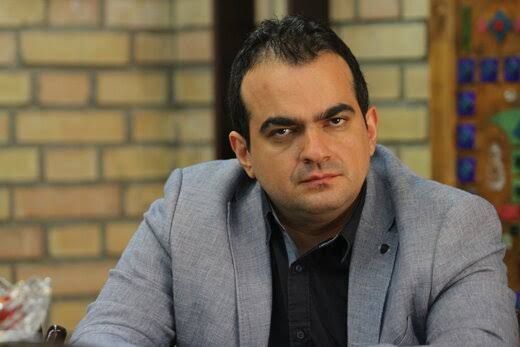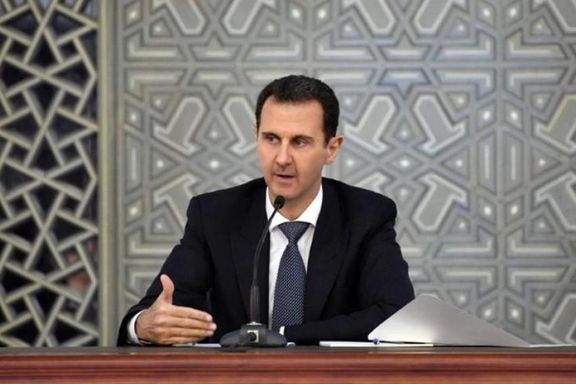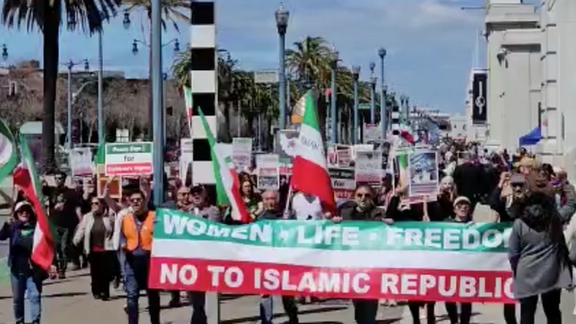Israel Says It Downed Aircraft That Appeared To Come From Syria

The Israeli army said it downed an unidentified aircraft on Sunday that appeared to have crossed into its territory from Syria, as tensions simmer in the region.

The Israeli army said it downed an unidentified aircraft on Sunday that appeared to have crossed into its territory from Syria, as tensions simmer in the region.
The Israel Defense Forces (IDF) said in a statement the aircraft it downed did not pose a threat at any stage.
Israel has for years carried out attacks against what it has described as Iran-linked targets in Syria. According to the Syrian Observatory for Human Rights, Israel conducted six strikes in Syrian territory in March alone.
Israel conducted three missile and air strikes from Thursday to Sunday on targets in Syria housing Iranian IRGC and proxy military forces.
Iran announced that two of its "military advisers" in Syria were killed in these attacks and warned that it would retaliate.
Israel has been regularly attacking targets in Syria since 2017 to weaken Iran's attempts to strengthen its military presence in the war-torn country and build up a threat on Israel's northern borders.
Iran has considerable drone capabilities that it has used against US bases in Syria as recently as last month, killing a US contractor and injuring at least eight US servicemen.
Iran's government spokesman, Ali Bahadori-Jahromi, tweeted Sunday that Israel's "terrorist acts will not remain unanswered."
Iran had also called on Palestinian militants to "use the opportunity" of internal political tensions in Israel to harm the "Zionist enemy."

Iran hit a new record in annual inflation in the calendar year which ended on March 20, but pundits say the country will go into hyperinflation this year.
Hyperinflation is a very high and typically accelerating inflation, which quickly erodes the value of the local currency -- rial in this case -- while the prices of all goods increase exponentially. In such a situation, people move to minimize their holdings in the national currency and switch to more stable assets.
The Central Bank of Iran announced late in March that the annual inflation rate stands at 46.5 percent. Although the official inflation rate is usually less than what actual prices reflect, even a 46.5-percent inflation is among the highest in Iran in more than 30 years.
The bank did not disclose the point-to-point inflation for the last calendar month, which ended on March 20, but it provided the price index for the month, from which point-to-point inflation can be extracted. The price index was 794.3, which means a 64-percent point-to-point inflation rate compared to the corresponding period of the previous year at 484.6.
It is the second time Iran recorded such a figure since World War II. Considering the devaluation of the rial from 260,000 against one dollar to about 540,000 in the past 12 months, the inflation rate is expected to hit new highs in the coming months. Food prices have been rising much faster, with official figures indicating between 70-100 percent annual inflation for basic food items such as meat and dairy.
Hyperinflation is often associated with some form of stress to the government budget, such as socio-political upheavals, a collapse in aggregate supply of needed commodities, or obstacles in exports, all of which are seen in Iran’s economy.
There are different definitions for hyperinflation, with American economist Phillip Cagan defining it as when the monthly inflation rate exceeds 50 percent -- equivalent to a yearly rate of 12974.63% -- and the International Accounting Standards Board saying that it occurs when a cumulative inflation rate over three years approaches, or exceeds, 100 percent.
The Islamic Republic is currently facing the boldest antiregime protests since its establishment. Rising inflation may also lead to further protests.
The regime grapples with a serious revenue shortage mainly due to US sanctions and the Central Bank is printing more and more money which is aggravating the situation and most probably pushing the country towards hyperinflation.

In an article published on April 1, Khabar Online website cited market analyst Siamak Ghassemi as saying that the data released by the government about market liquidity and money supply bears “important and dangerous information” about the country’s economy in the coming months.
“The growth rate of the monetary base has reached 38 percent and liquidity has reached 34 percent. This unprecedented gap means that the government is printing more money and making up for the budget deficit by heavily borrowing from banks and forcing them to borrow from the central bank,” he said.
Ghassemi highlighted that the sharp growth of the monetary base and the significant budget deficit as well as increasing lack of trust in the government’s ability to bounce back as well as the continued devaluation of the rial will put Iran's economy on the brink of a three-digit inflation rate or hyperinflation.
The former governor of Iran's central bank Abdolnasser Hemmati, who is among the outspoken critics of the current administration, also said last week that “in order to control inflation and rial’s exchange rate, the government should take serious measures to reverse growing liquidity.”
When the central bank resorts to printing money without sufficient economic growth or foreign currency revenues, the money supply increases fast, which in turn leads to more currency devaluation and inflation. The biggest immediate reason for printing money is government borrowing from the Central Bank of Iran to bridge its budget deficit estimated to be 50 percent.
The Islamic Republic has been struggling with high inflation since 2019, but the raging inflation in the past Iranian year was different from previous years. Last May, the government eliminated an annual food import subsidy of at least $10 billion, which immediately led to steep price increases. This was followed by a fall in the value of the national currency, making imports more expensive for the population. Iran’s ruler Ali Khamenei has dubbed the new year as “the year of controlling inflation”, a promise also repeated by President Ebrahim Raisi, but reminiscent of similar slogans in previous years.

A top British military adviser says Tehran is making "bad choices" through military cooperation with Moscow, warning the allegiance could lead to instability in the Middle East.
Air Marshal Martin Sampson, who is a veteran of 500 air combat sorties across the Middle East, said the two allies posed threats globally, including the provision of Iranian drones to Moscow, used in the invasion of Ukraine.
“Our friends in the region should be a little bit nervous about what comes back [to Tehran] in return for that support [for Russia],” he said, in an article in The National.
“We need to be aware of anything that flows in the opposite direction [from Russia], because Iran's practical behaviors have been destabilizing in the region. Everybody should be concerned about the transfer of technology,” he stated.
He stated that a country which aligns with an invading power such as Russia, is making a “bad choice”, the two nations becoming increasingly close since suffering crippling global sanctions, Iran for its nuclear program and Russia, for the war in Ukraine.
Britain's top military adviser stated that it is highly likely that Iran is receiving missile equipment and advanced drone technology from Russia in lieu of finances, given its current sanctioned status. It is also likely that Iran is seeking Russian support for its nuclear program, after the JCPOA talks broke down last year.
Since the uprising in Iran, Russia has provided the regime with communication-surveillance capabilities as well as eavesdropping devices, advanced photography devices and lie detectors, as it supports the brutal crackdown on protesters and civilians.

Saudi Arabia is planning to invite Syrian President Bashar al-Assad to an Arab League summit that Riyadh is hosting in May, three sources familiar with the plans told Reuters.
The move would formally end Assad’s regional isolation.
Saudi Foreign Minister Prince Faisal bin Farhan will travel to Damascus in coming weeks to hand Assad a formal invitation to attend the summit scheduled for May 19, two of the sources said.
Assad's attendance at an Arab League summit would mark the most significant development in his rehabilitation within the Arab world since 2011, when Syria was suspended from the organization.
Syria's return to the 22-member body would be mostly symbolic but it reflects a change in the regional approach towards the Syrian conflict.
Last month sources told Reuters Riyadh and Damascus had reached an agreement to reopen their embassies after the Muslim holy month of Ramadan.
One of the three sources said discussions have been ongoing for more than a year over a list of demands from Saudi Arabia, including close cooperation on border security and drug trafficking.
Arab League heavyweight Egypt has also resumed contacts with Assad. Both sides agreed to strengthen cooperation on Saturday during the first official visit by a Syrian foreign minister to Cairo in over a decade.
Some countries, including the United States and Qatar, have opposed the normalization of ties with Assad, citing his government's brutality during the conflict and the need to see progress towards a political solution in Syria.
Contacts between Saudi and Syrian officials gathered momentum following a landmark agreement in March between Saudi Arabia and Iran, Assad's main backer, to re-establish ties.
The rapprochement between Riyadh and Tehran is part of major regional realignment, amid rising tensions between Iran and Israel.
Reporting by Reuters

Iran’s navy claimed Sunday that it warned off a US Navy EP-3E aircraft after it entered the country's border close to the Gulf of Oman, the Tasnim news agency reported.
Tasnim, which is affiliated with the Revolutionary Guard (IRGC), did not provide more details but its brief report indicated it was the traditional army’s navy that warned off the US plane, and not the IRGC navy.
The plane then moved away from the country's air border and returned to international routes, Tasnim said.
The EP-3E is a land-based multi-intelligence reconnaissance aircraft based on the P-3 Orion airframe, but upgraded from signal intelligence to multi-intelligence role, according to US Navy’s description.
Iranian naval forces occasionally harass US Navy vessels in the Persian Gulf region, often using armed speedboats that approach dangerously close to warships. On some occasions, US forces have fired warning shots during such encounters.
The US Central Command in charge of all military forces in the Middle East has not issued any statement about the incident claimed by Iran.
Iran has repeatedly said its ultimate goal is to drive the United States out of the region, including from Iraq, Syria and the Persian Gulf region.
In December and January, the US and British navies have stopped several un-flagged vessels in the Gulf of Oman and the Arabian Sea that were transporting weapons from Iran to the Houthi fighters in Yemen and confiscated large quantities of arms and ammunition.
The US Justice Department announced Friday that it has filed a forfeiture motion over the confiscated ammunition and material.

Iranians around the world held rallies and demonstrations on Saturday to declare solidarity with the uprising and call for an end to the Islamic Republic.
The rallies were held on Islamic Republic Day, a public holiday in Iran marking the anniversary of the beginning of the Islamic Republic, with hundreds of Iranians coming out to demonstrate.
According to the regime, the results of a public referendum in 1979 were a resounding 98.2% vote for the establishment of an Islamic state, but today, the picture looks very different.
Iranians held rallies in US and Canadian cities while videos from Sweden, Oslo and Denmark show the opponents of the Islamic Republic going to symbolic ballot boxes to say "NO" to the regime.
Similar events were also held in Brisbane, Leeds, Karlsruhe, Berlin and Barcelona.
In 2021, the Ministry of Foreign Affairs of Iran published statistics, which showed that 4,037,258 Iranians are living abroad, an increase from previous years. It is believed those numbers are growing, the largest population found in the US.